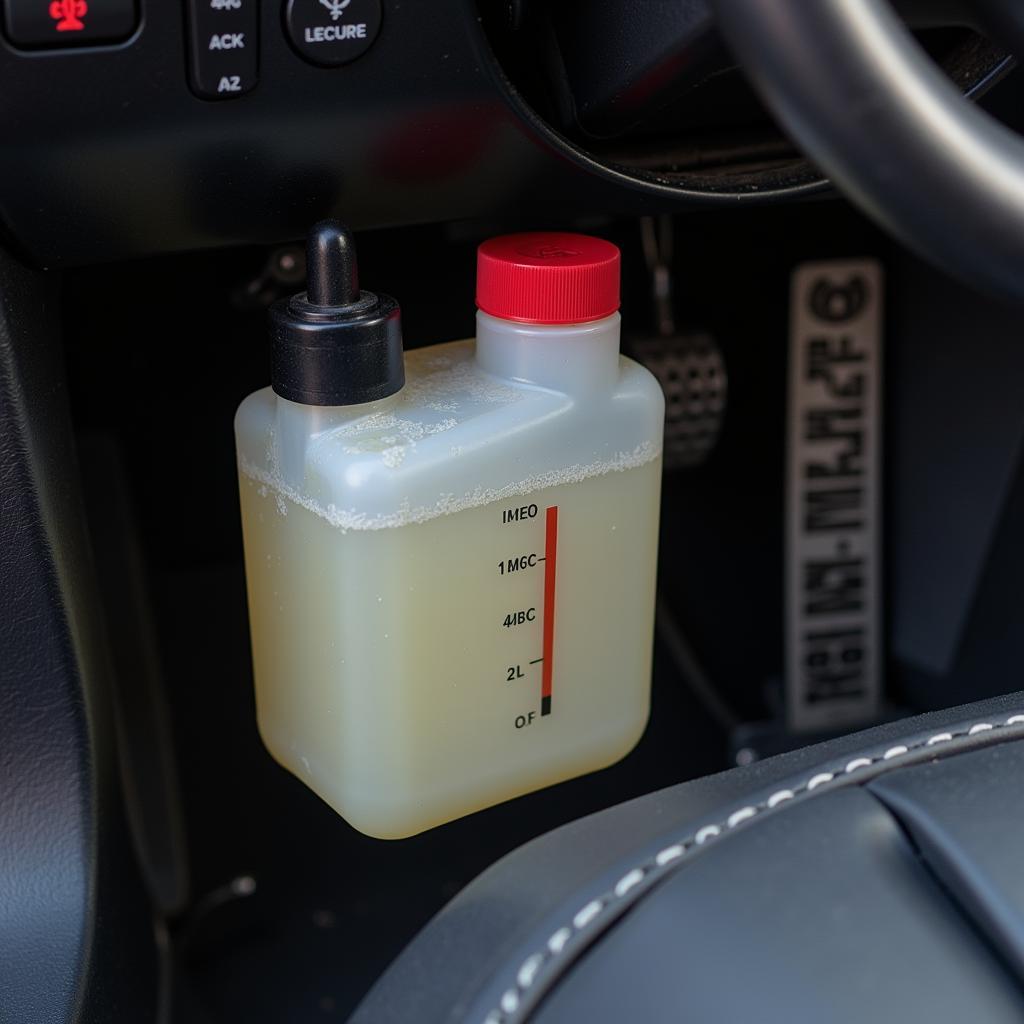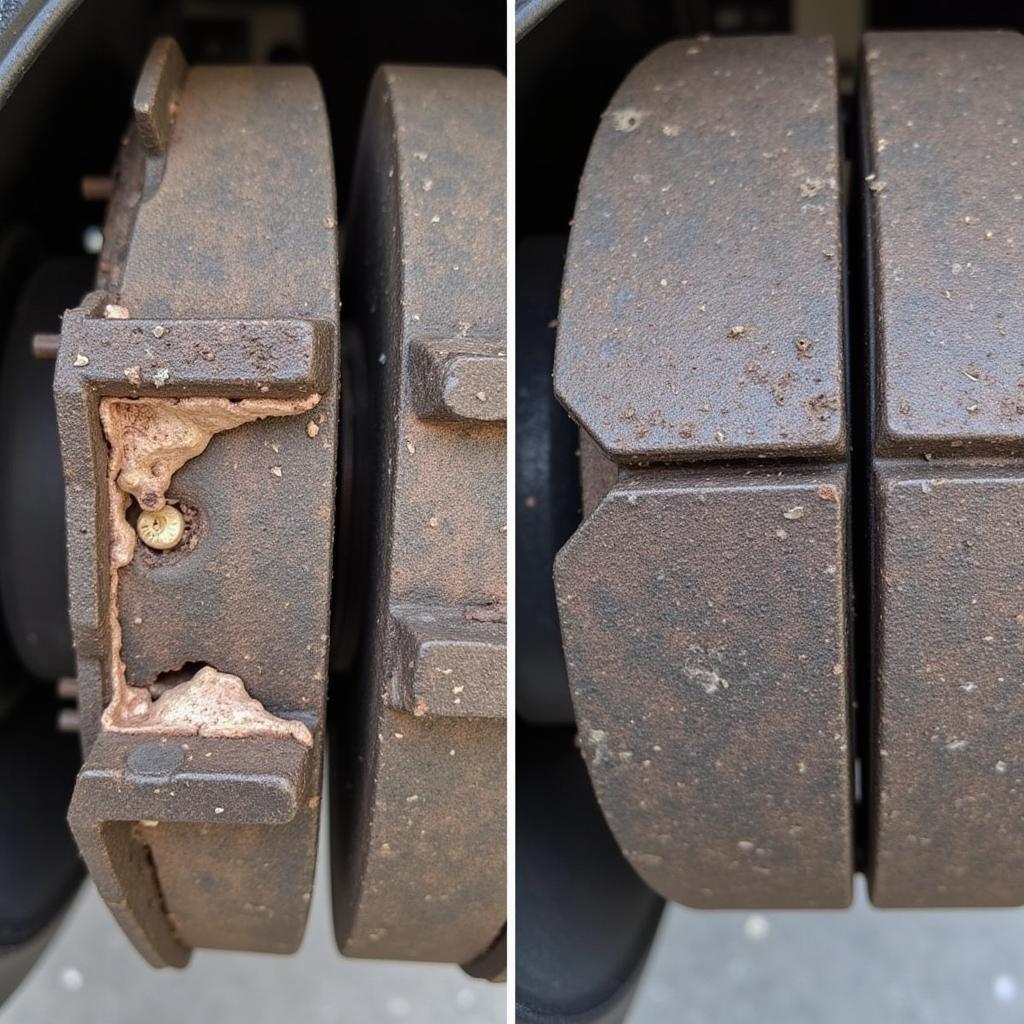The brake warning light on your dashboard, often a red circle with an exclamation mark or the word “BRAKE,” is a crucial safety feature. When it illuminates, it signals a potential issue within your braking system demanding immediate attention. Ignoring it could lead to decreased braking performance and dangerous driving conditions. This guide delves into the common causes of a brake warning light, how to troubleshoot them, and essential preventive measures.
Why is My Brake Warning Light On?
Several reasons can trigger the brake warning light. Let’s explore some of the most common culprits:
1. Low Brake Fluid Level
The most frequent cause is low brake fluid, often indicating a leak within the system. Brake fluid transmits force from the brake pedal to the wheels, enabling your vehicle to stop. A leak disrupts this process, reducing braking efficiency.
 Car Brake Fluid Reservoir with Low Level
Car Brake Fluid Reservoir with Low Level
2. Worn Brake Pads
Brake pads are designed to wear down over time due to friction. When they reach a critically thin point, the brake pad wear sensor activates the warning light, signaling the need for replacement.
 Comparison of Worn and New Brake Pads
Comparison of Worn and New Brake Pads
3. Faulty ABS System
Modern vehicles are equipped with an Anti-lock Braking System (ABS), preventing wheel lockup during hard braking. A malfunction within the ABS system, such as a faulty wheel speed sensor, can trigger the warning light.
4. Parking Brake Engaged
While seemingly obvious, accidentally leaving the parking brake partially engaged happens more often than you think. This can illuminate the warning light, and you might notice a dragging sensation while driving.
5. Brake System Malfunction
Beyond these common causes, other issues, like a faulty brake master cylinder, brake line blockage, or electrical problems, can also trigger the warning light.
What to Do When Your Brake Warning Light Turns On
If your brake warning light illuminates, follow these steps:
-
Pull over safely. Find a safe location to park away from traffic.
-
Check your parking brake. Ensure it is fully disengaged.
-
Inspect your brake fluid level. If comfortable doing so, carefully check the brake fluid level in the reservoir.
-
Avoid driving. If the fluid level is low, or you suspect a more serious problem, do not attempt to drive.
-
Call for professional help. Contact a qualified mechanic or roadside assistance to diagnose and repair the issue. Driving with a compromised braking system is extremely dangerous.
Can I Drive With the Brake Warning Light On?
Driving with an illuminated brake warning light is highly discouraged. It signifies a potential problem with your braking system, and continuing to drive could lead to brake failure.
How to Prevent Brake Warning Light Issues
Preventing brake problems is always better than dealing with their consequences. Here are some proactive measures:
-
Regular Brake Inspections: Have your brakes inspected annually or as recommended by your vehicle manufacturer.
-
Adhere to Brake Fluid Flush Intervals: Consult your owner’s manual for recommended brake fluid flush intervals.
-
Pay Attention to Unusual Noises: Be alert for any unusual noises like grinding or squealing while braking, indicating potential pad wear.
-
Avoid Riding the Brakes: Prolonged pressure on the brake pedal generates excessive heat, leading to premature wear.
When to Consult a Mechanic
While checking your parking brake and brake fluid level can be done independently, it’s crucial to remember that diagnosing a brake system requires specialized knowledge and equipment.
Here’s when to seek professional help:
-
Low Brake Fluid: If the brake fluid level is low, there’s likely a leak that needs immediate attention.
-
Brake Warning Light Remains On: If the light stays on even after adding brake fluid, a deeper issue needs addressing.
-
Soft or Spongy Brake Pedal: This indicates air in the brake lines, requiring a brake bleed procedure.
-
Unusual Noises While Braking: Grinding, squealing, or clicking sounds during braking often signal worn brake components.
-
Pulling or Vibrations During Braking: These sensations can indicate warped rotors or uneven brake pad wear.
“Addressing brake issues promptly is non-negotiable,” says automotive engineer and diagnostics specialist, David Miller. “Ignoring warning signs can compromise your safety and lead to costlier repairs down the line.”
FAQs About Brake Warning Light Meaning
1. What should I do if my brake warning light flashes?
A flashing brake warning light usually indicates an issue with your ABS system. While your regular brakes may still function, ABS functionality might be limited. Consult a mechanic for diagnosis and repair.
2. Can a bad brake light bulb cause the brake warning light to come on?
While not directly related, a bad brake light bulb can sometimes cause a voltage fluctuation that triggers the warning light. It’s always best to replace blown bulbs promptly.
3. Is it safe to add brake fluid myself?
Yes, you can add brake fluid yourself, but ensure you use the correct type specified in your owner’s manual. However, it’s crucial to remember that simply adding fluid without addressing the root cause of a leak is not a solution.
4. How much does it cost to fix a brake warning light issue?
The repair cost varies significantly depending on the underlying cause. It can range from a simple brake pad replacement to a more complex ABS module repair.
5. How often should I get my brake pads replaced?
Brake pad lifespan depends on driving style and conditions. However, it’s generally recommended to have them checked every 12,000 miles and replaced as needed.
Conclusion
Understanding the brake warning light meaning is crucial for every driver. Recognizing the potential causes and taking appropriate action can prevent accidents and ensure your safety on the road. Remember, when it comes to brakes, prompt attention and professional help are essential. Ignoring warning signs can have serious consequences.
